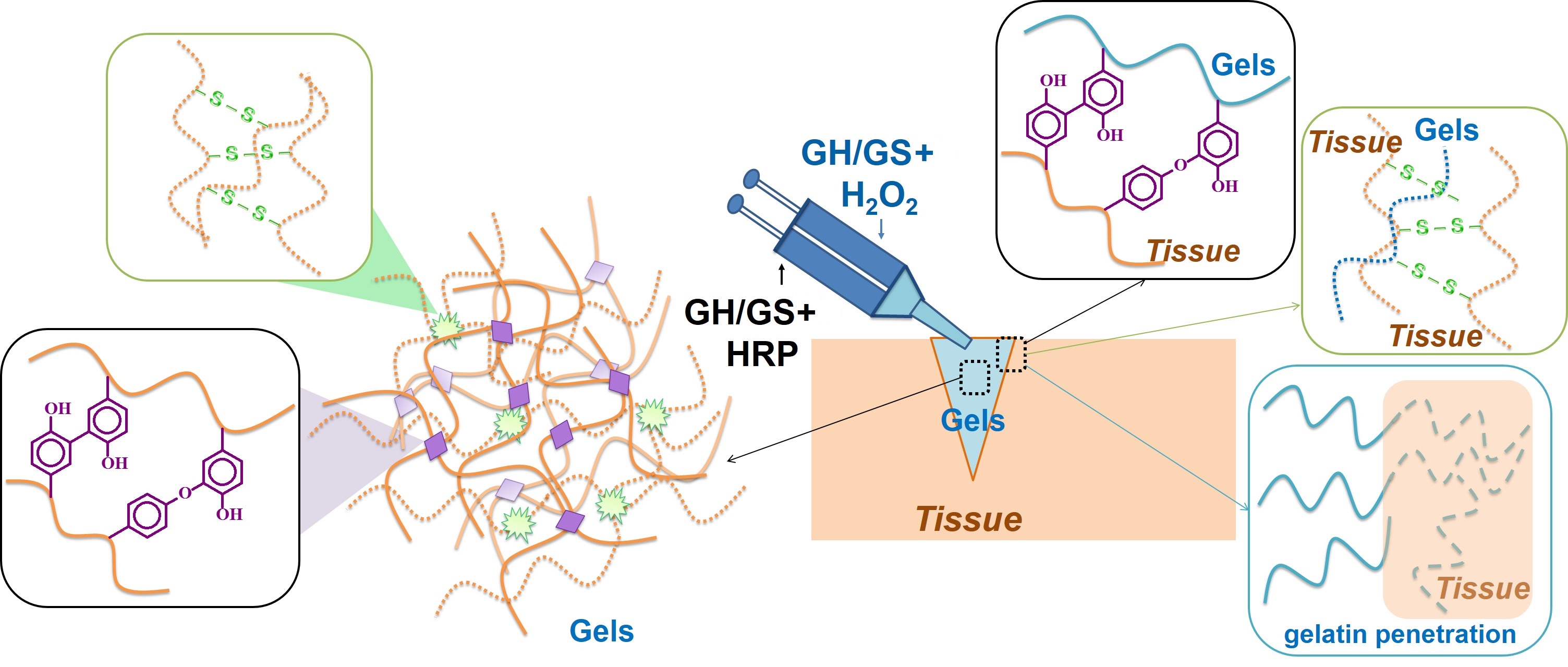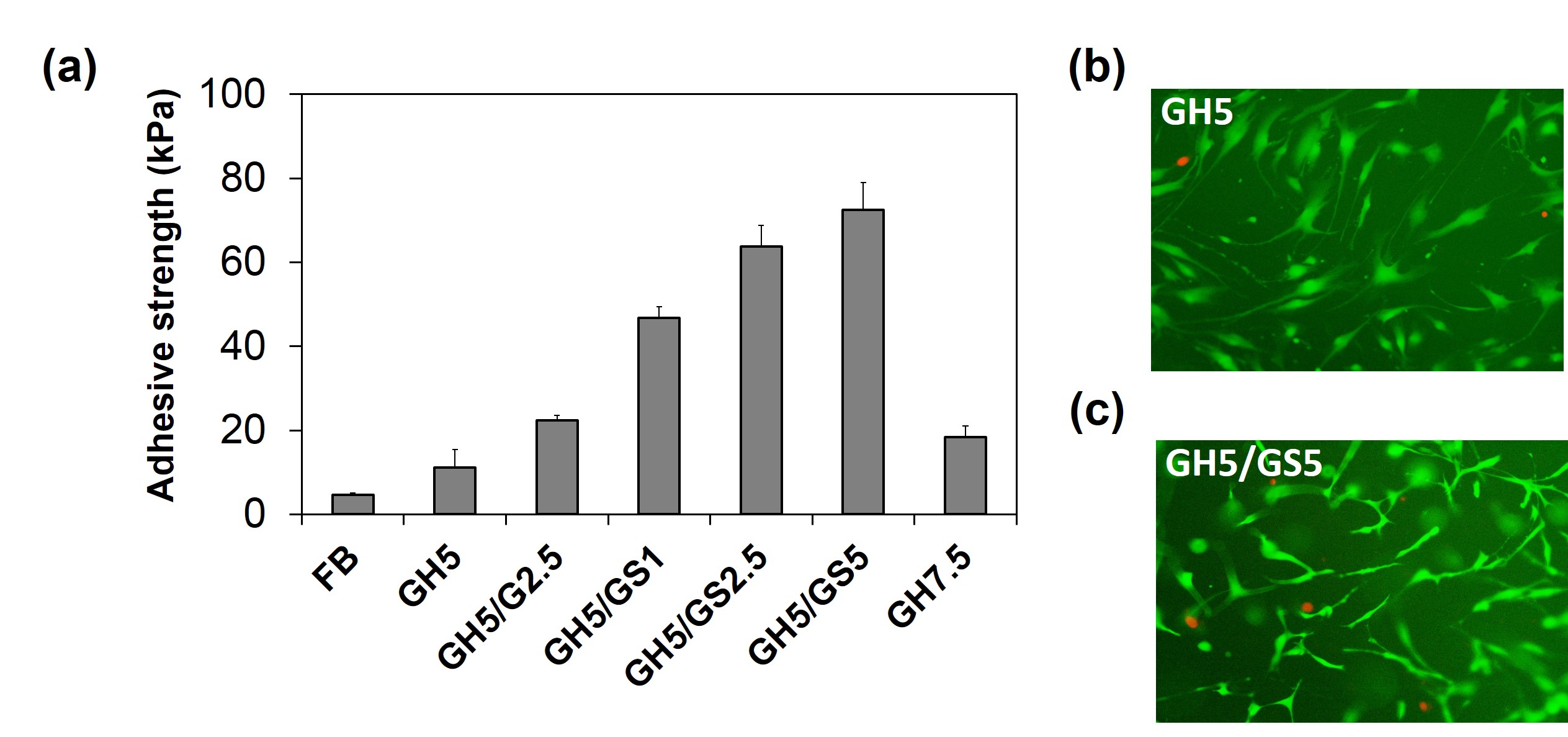Introduction: Tissue adhesives have received much attention as alternative materials to medical sutures and staples. Although they have been widely used for the wound closure and management, their adhesive strength and biocompatible properties are still need to be improved for variously clinical applications. Thiomers are promising candidates for adhesive improvement since thiol groups can react with cysteine-rich glycoproteins on tissue to form disulfide cross-linked networks[1]. We thus hypothesized that adhesive strength of 3-(4-hydroxy-phenyl)-propionic acid-gelatin (GH) hydrogels formed by horseradish peroxidase (HRP)-catalyzed oxidation can be improved with the addition of thiolated gelatin (GS). Furthermore, HRP not only catalyzes the oxidative coupling of phenols but also induces the disulfide formation in the presence of H2O2 or under aerobic condition[2]. This combination leads to form synergistic networks of phenol-phenol and disulfide bonds for increasing an intragel crosslink and extra gel-tissue interactions (Fig.1).
Materials and Methods: GH was synthesized by coupling primary amine of gelatin with the carboxyl group of 3-(4-hydroxy-phenyl)-propionic acid using EDC/NHS chemistry[3]. To prepare thiolated gelatin, 1,4-dithio-DL-threitol was used to break SS-bond of cystamine-conjugated gelatin. The chemical structure of GH and GS were characterized by 1H NMR and FT-IR. The phenol content of GH and thiol content of GS were determined by UV-Vis spectroscopy and Ellman’s assay. The GH/GS hydrogels were fabricated using HRP/in the presence of H2O2. To explore the effect of thiol degree on hydrogel properties, the gelation time, elastic modulus, swelling behavior, degradation rate and adhesive strength were investigated as a function of GS concentration. In vitro cell studies were carried out using human dermal fibroblasts (hDFBs) on GH/GS hydrogel surfaces to test their cytotoxicity.

Fig 1. Schematic representations of in situ forming GH/GS hydrogels with the possible mechanisms.
Results and Discussions: GH and GS were synthesized successfully with the phenol content of 140 μmol/g and thiol content of 137 μmol/g. GH/GS gels were formed within 15 seconds to 5 minutes depending on GS and HRP concentration. Their elastic moduli were increased from 6.7 to 10.3 kPa following the increase of added GS concentration. The adhesive force of GH/GS (5/5 wt%) hydrogels (72.6 kPa) was 15.8 times higher than fibrin glue (4.6 kPa) and 6.5 times higher than GH only hydrogels (11.1 kPa) (Fig.2a) due to the disulfide formation between hydrogel and tissue, and the increase of inherently sticky gelatin content. Fluorescent images (Fig.2c) showed that GH/GS bioadhesives were non-cytotoxicity as compared to GH only hydrogels (Fig.2b). In addition, WST-1 results shown the GH/GS 5/2.5 and 5/5 wt% achieved 90 and 81 % cell proliferation as compared to GH only hydrogels that is an acceptable value for cytocompatible consideration.

Fig 2. Adhesive force of GH/GS hydrogels as a function of GS concentration (a). Live/dead staining images of hDFBs cultured on GH (b) and GH/GS (c) hydrogels after 3d.
Conclusions: In summary, GH/GS hydrogels exhibited fast gelation, tunable adhesion, excellent biocompatibility, showing a promising potential for use in a wide range of biomedical applications. Furthermore, disulfide bonds are the dynamic covalent interactions and sensitive to pH or redox potential that can be developed as a smart glue in our future study.
This work was supported by Basic Science Research Program through the National Research Foundation of Korea (NRF) grant funded by the Ministry of Science, ICT & Future Planning (2015R1A2A1A14027221)
References:
[1] Bernkop-Schnurch, Adv. Drug. Deliv. Rev., 2005, 57, 1569.
[2] S. Singh, F. Topuz, K. Hahn, K. Albrecht, J. Groll, Angew. Chem. Int. Edit., 2013, 52, 3000.
[3] Y. Lee, J.W. Bae, D.H. Oh, K.M. Park, Y.W. Chun, H.-J. Sung and K.D. Park, J. Mater. Chem. B, 2013, 1, 2407.